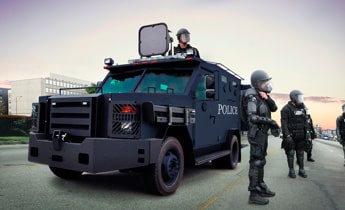War and defense tend to yield high technology weapons for use by everyone from military police to battlefield weapons for infantry. The Iraq and Afghanistan Wars have each yielded new technologies in weapon designs, and one in particular which deviates from our preconception of battlefield weapons. We often think of battlefield weapons to be those which cause immediate injury or harm through projectiles, shrapnel, or fragments. The concussion sound, boom, and what is really a shockwave, are often mired in this preconception of wartime weapons.

Inventiveness became invention; hence, the design of acoustic weapons. Large units are currently deployed to disperse crowds in areas of conflict or non peaceful demonstration.
This is hard to imagine. As an acoustic weapon, it does not explode your eardrum, does not infiltrate your skin or tissue, but it does radiate your eardrum and head. More importantly, it goes directly to the cochlear mechanism of the ear.
The Long Range Acoustical Disruptor (LRAD) is most famous for use against civilians during military operations. Its 153dB sound waves are so powerful that they cause bystanders to reel in pain, clutch their ears, and run away.
Other than the eardrum, which receives most of our vocal information, there are two other important elements of the head which give us other information or sound. The most basic and the one that derives low frequencies is called the mastoid process. The mastoid process incorporates the skull, air spaces, fluid spaces, and the dynamics surrounding the inner ear to provide these low frequency sounds. That’s why we can hear rumblings of earthquakes or railroads in a distance. It is also cause for significant trauma in large munitions blasts and the production of associated anxiety. For instance, many people find it difficult to sleep with thunder outside.
The other hearing method resides at the highest end of our hearing frequency spectrum. High frequencies have a direct injection to the ear through the cochlear process. The cochlea in the ear receives almost all signals, but once frequencies go past the ability of the eardrum to vibrate, for instance very high sounds, the sound goes directly to the cochlea. It has the most direct path to the auditory nerve. That is why shrill metallic sounds get our speedy attention. Again, due to this direct involvement, pistol practice shooting, listening to rock at high levels, or having a career in log splitting, will tend to cause loss of hearing quickly because of the direct intrusion and the nerves being damaged due to this sensitivity in the cochlear listening range at the higher frequencies.
The scientists and developers who designed acoustic weapons used this cochlear phenomenon to create an extremely uncomfortable sound that can only be described as the screeching of chalk multiplied a million-fold. Whether you’re affected by the screeching of chalk on a blackboard or a metallic chair scraping across a floor, imagine this unrelenting sound at a level which exceeds anything you’ve ever heard in your life being thrown at you with the sound impacting your very being until it is turned off. Then, just to cause pain, it cycles incessantly at top volume at about 3-5 cycles per second.
The level of sound intensity, which is a scientific term, would be louder than anything you’ve possibly heard – as loud as a jet engine but with the screeching of a chalk board. It is meant to irritate, inflame, disturb, disorient, disable, and degenerate your activity into withdrawing and getting away.
You might be thinking we’re talking about 15 seconds of intense sound, perhaps a minute or two; or maybe even 5 seconds to get rid of everyone in your path. Except in reality, it takes but a split second. The sound is so intense, disrupting, and disorienting that to quote a Missouri news source, Carl Gruenlar, a former Vice President of American Technology Corporation (which later became LRAD Corporation) said that the device will produce instant headaches, permanent hearing damage, and that you definitely dont want to be within 100 meters of the device. Of course, that was said in 2004, before the company began marketing its weapons to domestic government agencies.
It is like injecting sound directly into your brain. So, when we speak of bringing military equipment used for crowd dispersal into the hands of local law enforcement, we need to be wary, very wary.
Little is understood about the propagation of these devices in streets used by police. Imagine a neighborhood with both a peaceful protest of hundreds of protesters and a few who act out, the police being called in and having been trained, using this acoustical weapon. By turning this unit on, they have immediately impacted the audible senses of not only the disturbants, but also the peaceful protesters and the neighborhood at large. What is important to realize is that the sustained energy to the central nervous system via the auditory nerves may cause significant damage to children under three years old. The question is how much damage is caused by acoustic weapons to the ear, central nervous system, or the physical body.
These devices can be as large as a piece of furniture or as small as a carton of cigarettes, even battery powered. What’s interesting is that there are no scientific studies that have been conducted to assess the potential for damage to the young, the elderly, or those who have limited capacity. It is also not known what the effects are to those in law enforcement who use the devices.
It can only be imagined that several cases of disability claims or hearing loss will occur as a matter of use. Nor have ear protectors even been seen as a protection against self infliction by the responding agencies.
According to the Memorandum on Conventional Weapons (CCW), Delegates from the Arms Division of Human Rights Watch dated December 16, 1999, With the banning of blinding laser weapons by the international community in 1995, acoustic weapons are the next new antipersonnel weapon to emerge based upon novel and/or unconventional physical principles. Such a completely new technology demands the closest scrutiny to ensure compliance with domestic and international law, as well as societal acceptability. Yet there has been almost no debate about research into acoustic weapons. Human Rights Watch is concerned that development moves forward without any realistic appreciation of the military dimensions of acoustic weapons, without a full understanding of the human effects, and with a deficient appreciation of social, policy and legal questions.
The device was recently used in New York City and reported by the New York Times. The Times had no idea what to make of it because there is so little information having been reported. Time will tell if this weapon has useful potential to reduce physical harm, or greater potential to increase the imperceptible damage to hearing and central nervous system to both actors and protectors.






